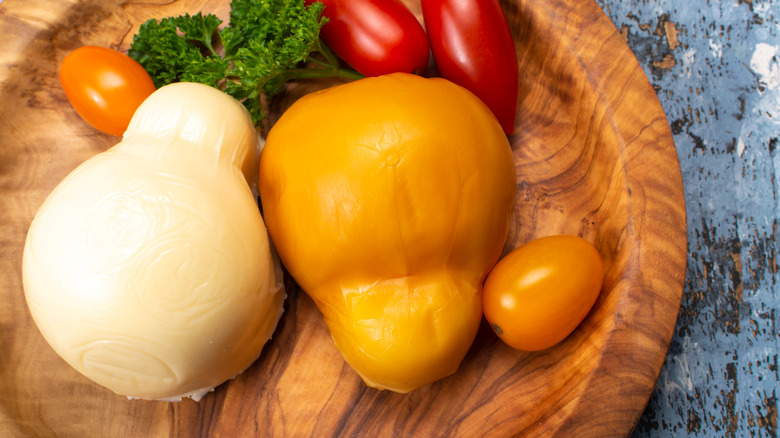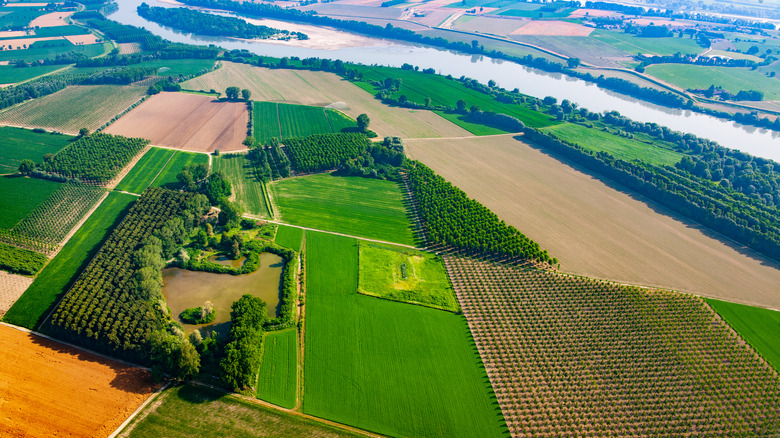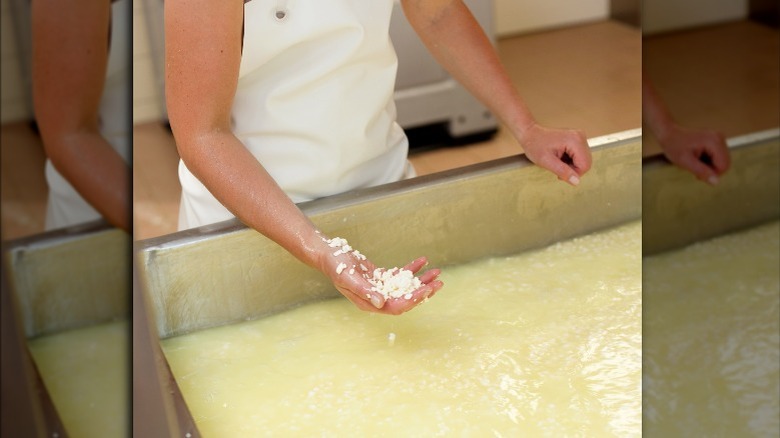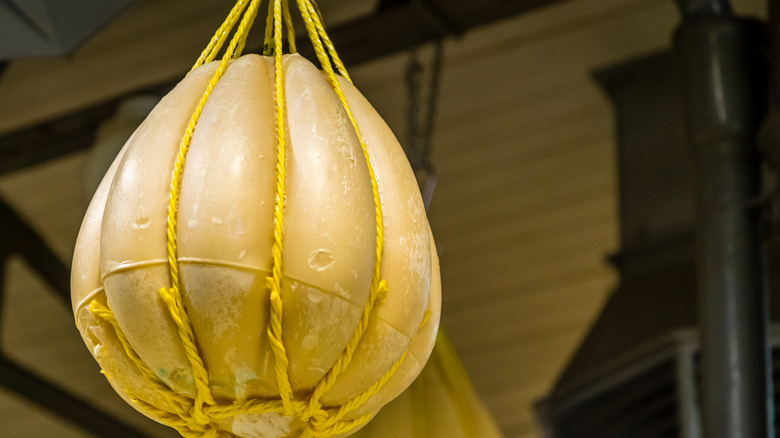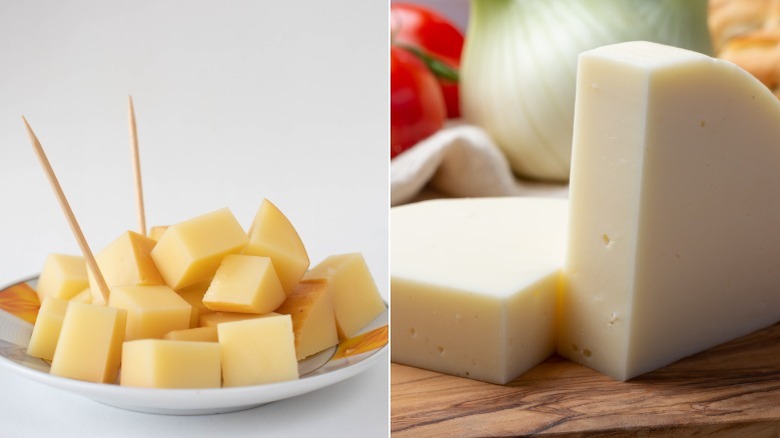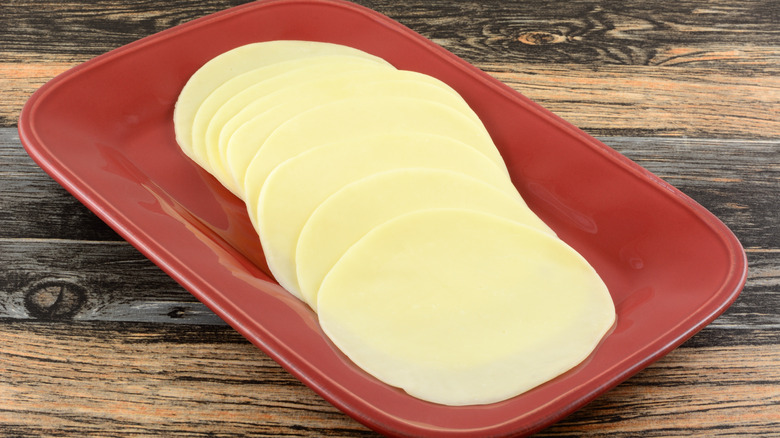The Untold Truth Of Provolone Cheese
Provolone is one of the most popular Italian cheeses. Made from cow's milk, buffalo milk, or a combination of the two, it has a long history dating back to the early 1800s, says Taste Atlas. It is a "pulled" cheese, and sometimes referred to as the older brother of mozzarella (according to New England Cheese Making Supply Company). Hard, aged provolone is a classic part of antipasti platters, and the softer versions are known for their role in Philly cheesesteak sandwiches, burgers, and pizza.
Shaped in cheese molds into beautifully rounded forms, the name was derived for its trademark "prova" shape — the term in the Neapolitan dialect for "globe" (via Gourmet Cheese of the Month Club). Italian provolone comes in two distinct varieties, and cheese makers can adjust the flavor and texture of provolone to produce a milky, creamy, and semi-firm variety to a hard, piquant, funky cheese. Here is everything you ever wanted to know about delicious, diverse provolone.
Provolone originated in Southern Italy, but dairy farmers brought it north
Provolone cheese originated in Southern Italy, but also found a new home in the north during Italy's Unification Period (per Taste Atlas). This time in Italy's history came after the fall of the French Emperor and self-proclaimed "King of Italy," Napoleon Bonaparte, who had conquered and divided his Italian neighbors into separate "kingdoms" (via the U.S. State Department). Post-Napoleon, in the early 19th century, Italians were more free to travel between regions, and it was during this era that an increasingly mobile Southern Italian population began to move north, into the fertile Po Valley agricultural area, bringing the traditions of dairy cattle farming and the "stretched-curd" cheese-making technique with them (more on stretched-curd cheese in a bit.)
This cheese became known as Provolone Valpadana ("Provolone" was the common Southern Italian term at the time for cow or buffalo cheese, and "Valpadana" refers to Po Valley.) In Italy, the Po Valley, particularly in the Lombardy and Veneto regions, is still known for producing the world's best provolones (via Cheese.com).
Provolone is a 'pasta filata' cheese
"Provolone" is a derivative of terms from the Neapolitan dialect. "Prova," or "provola," mean globe or globe-shaped (via The Spruce Eats). Provolone, like mozzarella, is one of Italy's "pasta filata" cheeses, a term which means "spun taste." Pasta filata cheeses (per Culture: The Word on Cheese magazine) are distinguishable because pieces can be pulled off in strips, like the string cheese you loved in your grade school lunch box. These cheeses have a stretchy, buttery texture they owe to a stretched-curd or pulled-curd method of making cheese.
Like any cheese, pasta filata cheeses such as provolone begin with milk curds that are cut into pieces and drained of whey. Then comes the "filatura" (spinning). The curds get a bath of hot whey or water. When the curds float, the liquid is drained off and the cheese makers mix and knead the curds until they become a soft, stringy mass. This lump is divided into smaller sections by forming balls of it or by pulling off a thick strand, kind of like a taffy pull, explains Culture: The Word on Cheese magazine.
Provolone is mozzarella's 'older brother'
According to Italian Food Excellence, the shape of a provolone depends on the way it is molded before it is aged. You may have seen provolone in the shape of a salami, a melon, or a teardrop hanging in your local Italian specialty food store. According to Gourmet Cheese of the Month Club, provolone cheeses can range in size from half-pound orbs to massive "torpedoes" weighing 200 pounds.
Because it is very soft when first molded, provolone is not placed on shelves to dry, as this would flatten the product. Instead, it is tied with intricately-knotted cords and hung to age. These ropes leave distinctive grooves in the yellowish rind of the provolone. This rind often has a wax coating to prevent the cheese from growing bad molds (via Musco Food).
Provolone is sometimes referred to as the "older brother" of mozzarella because it is aged longer. Another distinction is their moisture levels. According to CNew England Cheese Making Supply Company, the moisture content of provolone is 45%, versus mozzarella's 52-60%. This, along with provolone's longer aging process, gives this cheese a fuller flavor than the younger mozzarella.
Provolone can be imparted with a smoky flavor before aging. According to the Gourmet Cheese of the Month Club, provolone is typically smoked with applewood. The ripening process takes place in temperature- and humidity-controlled aging chambers. Provolone can be further aged by retailers. Hung in cheese caves, experts sample large blocks of cheese to judge their ripeness before selling (via Zagat, on YouTube).
Italian provolone comes in two varieties
There are two types of Italian provolone. The hard, somewhat stinky cheese often found in antipasti platters is provolone piccante ("piquant"). It's made with goat or lamb rennet and goat lipase, and is different from the soft, mild provolone that's used on pizza. That provolone is provolone dolce ("sweet"), which is made with calf rennet and calf lipase. Lipases are important because they contain enzymes that allow the milk to curdle (via Gourmet Cheese of the Month Club). (Enzymes produced in the stomachs of animals play a role in the manufacturing of many cheeses, according to Carolina Knowledge Center.) Delicate-tasting provolone dolce has a white, creamy color and is aged two to three months. Its yellower, sharper, more robust sibling is aged for at least four months, and more often, six to 12 months, or even up to three years (via Culture). The hard texture of provolone piccante makes it suitable for small cubes on cheese plates or grated over pasta. Both dolce and piccante provolones can be "affumicato," or smoked.
According to The Spruce Eats, although the Po Valley still produces some of the world's best and oldest provolones, the cheese is now produced worldwide (although some would argue that not all of this is "true" provolone, says Cook's Illustrated.) According to Statista, in February 2016 the US produced about 29 million pounds of provolone — slightly more than Swiss (24 million pounds), but much less than mozzarella and cheddar (341 million and 258 million, respectively).
Americans developed a third variety
According to Cook's Illustrated, American cheese makers developed a third variety of provolone, and this is the one you'll find sold bagged and cut into sandwich slices in the dairy aisle of your grocery store. It's aged for only two months, and unlike dolce and piccante varieties of provolone, these do not use animal enzymes in the separation of the curds. American provolone uses vegetarian enzymes. Different enzymes can be chosen by cheese makers, according to Cook's Illustrated, to give American provolones a wide variety of flavors nuances.
When tasters sampled piccante, dolce and American provolones, they described the American provolone variety as the softest, lightest and mildest of the three cheeses. In fact, some thought they were trying a different variety of cheese altogether. Described as "mellow and milky," American provolone is best for sandwiches and melting.
Whether hard, aged, and funky, or soft and sweet, provolone has earned its place on tables and in kitchens around the world.
